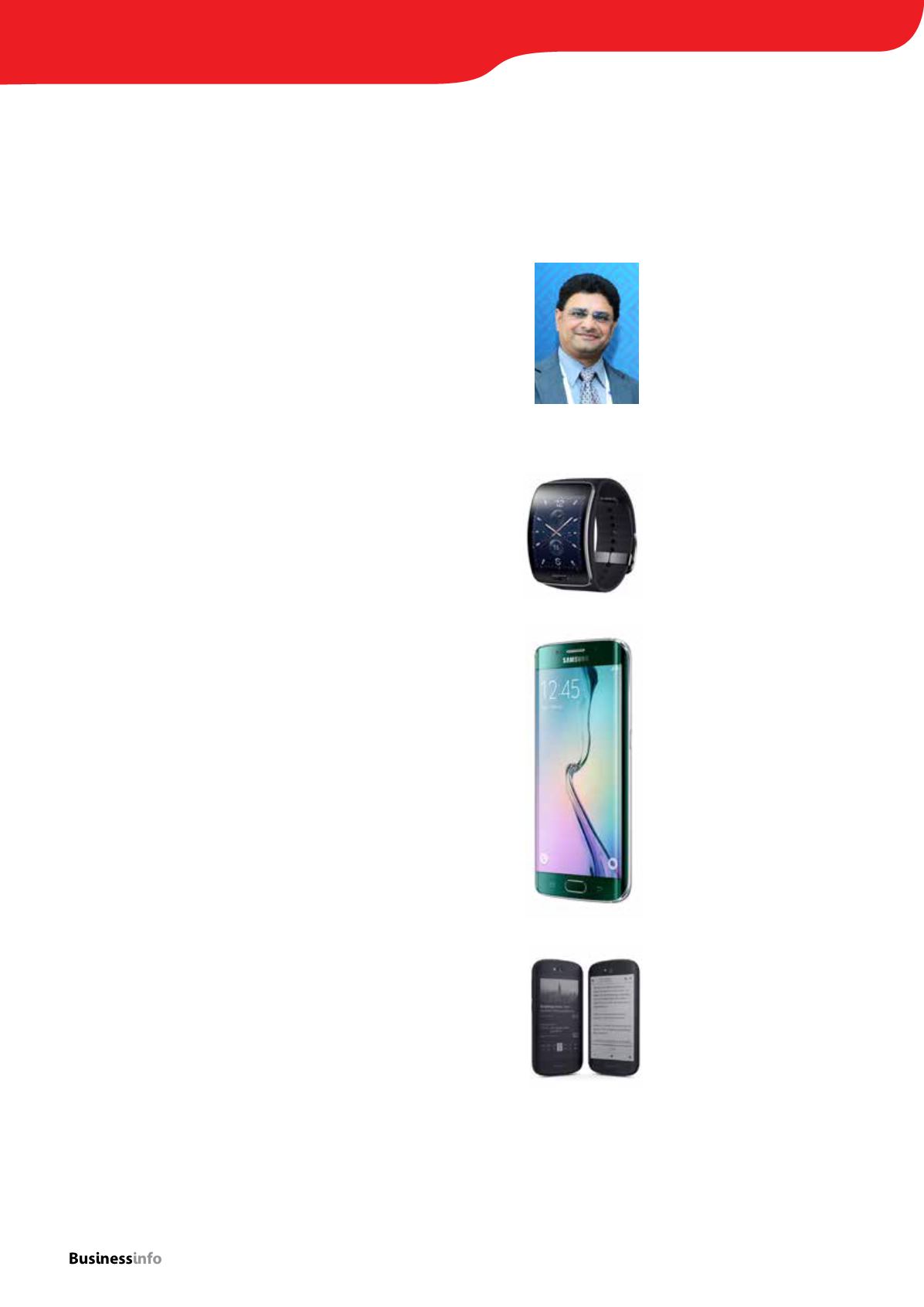
Top 10 Trends
in Displays
The global display industry continues
to grow, with new technologies
enabling a host of emerging products
and applications. To help you keep
track of what’s happening, here’s a
list of the top 10 trends in display
technology.
1.Wearables
The most high-profile entry to the
burgeoning wearable market, smart
watches will continue to be a hot topic,
as more and more companies release
their own versions.Wearables also
include fitness bands and, yes, smart
glass – wearable displays for virtual and
augmented reality (VR, AR). All of these
applications have to convey large amounts
of information on small displays that must
deliver high brightness and resolution with
very low power consumption. For this
reason, thinner, lighter organic LED (OLED)
and ePaper displays with better colour
performance are gaining market share.
Flexible OLEDs in particular have a bright
future in this category.
2. Curved Screens
Another area of heightened public interest,
curved screens have three primary
applications: TVs – with more of the
screen directed toward the focal point,
where the viewer tends to sit, curved
screens create a better viewing experience;
smartphones – curved screens make the
phone more aesthetically pleasing and
create new opportunities for viewing
information on the curved edge or side of
the screen; and car dashboards – curved
displays inserted into car dashboards will
greatly improve driver usability.
3. Quantum Dots
Market research firm IDTechEx expects
Quantum dot-enhanced LCD panels to
account for 14% of the TV market by
2020. Quantum dots (QDs) are light-
emitting semiconductor nanocrystals
that create intense red, green and blue
Sri Peruvemba, CEO of Marketer International and
Head of Marketing for the Society for Information Display,
outlines some of the key trends in displays.
Displays
businessinfomag.uk
magazine
24
colours. The dots can support large
LCDs, making them good candidates for
TVscreens and other applications. Backlit
QD-LCDs are garnering interest and
investment because they greatly improve
image quality while costing less than
OLED, as the LCD fabs are already in
place, many of them fully depreciated.
4. More Pixels/Enhanced Readability
Large-screen TVs with UHD/4K technology
are starting to hit the market in greater
numbers to meet demand for a range of
price points. In addition, there is beginning
to be a push for video of the same
high quality to be viewable on tablets,
wearables and other smaller screens.
This will require smaller displays that can
accommodate very high-quality content,
creating opportunities for companies that
can find ways to cram in more pixels per
unit of real estate.
5. Better Image Quality
Not everyone thinks more pixels are the
only way to enhance the user experience.
Pixelworks offers chipsets and algorithms
designed to optimise the quality of any
display. The technology is predicated
on the fact that, due to increased
pixel density, the human eye cannot
distinguish individual pixels. This makes
images more lifelike than ever.
6. Immersive Virtual Reality
Why can’t computing feel completely
natural? Rather than taking away from
the human experience, immersive VR
blends the digital and real world. Oculus
(now part of Facebook) has been working
on immersive VR, most famously for
its Oculus Rift product that creates a
stereoscopic 3D view and factors real-life
head and eye movement into how users
interact with the technology.
7. Foldable/Rollable Displays
We’ve already begun to see clothing with
embedded displays come to market, and
the eventual goal is to enable users to fold
down or roll up virtually any mobile device
and put it into a pocket. This creates a
huge opportunity for flexible OLEDs.
Samsung and LG Display are creating
flexible OLEDs that are literally changing
the shape and capabilities of their
latest smartphone offerings. Companies
like E Ink and Polyera are constructing
flexible ePaper displays that are aimed at
wearable devices.
8. Secondary Displays
An emerging trend is to have an always-
on secondary display on the back of
a mobile phone. Based on low-power
display technologies, these enable the
user to access information on the phone’s
existing footprint without draining the
battery. Examples include YotaPhone, an
Android phone with full-touch capacitive
screens on the front (AMOLED) and
back; popSLATE, an iPhone 6 cover that
converts the back of a phone into a
shatterproof e-paper screen; and the
Tegware Bagel, an iPhone 6 case with an
integrated e-writer that can be used to
jot down notes and sketches.
9. Displays for Writing
While many of us run our lives with a
smartphone, we still turn to pen and
paper for taking notes or doodling.
Studies show that we retain information
better when we use the connection
from brain to hand to write something
down, rather than simply entering or
scanning it into our phones. Displays for
writing are thus making a comeback.
Many tablets have a pen input feature
and new options are being developed for
smartphones, like the fore-mentioned
Tegware Bagel. Samsung’s Galaxy Note
incorporates pen writing and Kent
Displays manufactures the Boogie Board
line of e-writers.
10. Haptic Displays
Haptic technology is tactile-feedback
technology that recreates the sense
of touch by applying force, vibration
or motion to the user. It enhances the
keyboard typing experience on a display
and creates a more immersive experience
in gaming applications etc..
What’s exciting about many of these
trends is not just how they’ll be used, but
how they work – it’s the ingredients that
make these emerging technologies viable
and marketable.
Wearable
Sri Peruvemba
Curved Screen
Secondary Display


